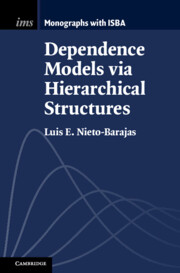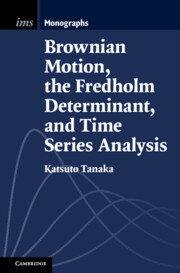Refine search
Actions for selected content:
3044 results in Probability theory and stochastic processes
1 - Introduction
-
- Book:
- Dependence Models via Hierarchical Structures
- Published online:
- 20 March 2025
- Print publication:
- 27 March 2025, pp 1-22
-
- Chapter
-
- You have access
- Export citation
8 - Multivariate Dependent Sequences
-
- Book:
- Dependence Models via Hierarchical Structures
- Published online:
- 20 March 2025
- Print publication:
- 27 March 2025, pp 118-124
-
- Chapter
- Export citation

Dependence Models via Hierarchical Structures
-
- Published online:
- 20 March 2025
- Print publication:
- 27 March 2025
2 - Integral Equations and the Fredholm Determinant
- from Part I - Theory
-
- Book:
- Brownian Motion, the Fredholm Determinant, and Time Series Analysis
- Published online:
- 19 December 2024
- Print publication:
- 02 January 2025, pp 63-159
-
- Chapter
- Export citation
Frontmatter
-
- Book:
- Brownian Motion, the Fredholm Determinant, and Time Series Analysis
- Published online:
- 19 December 2024
- Print publication:
- 02 January 2025, pp i-iv
-
- Chapter
- Export citation
Preface
-
- Book:
- Brownian Motion, the Fredholm Determinant, and Time Series Analysis
- Published online:
- 19 December 2024
- Print publication:
- 02 January 2025, pp vii-x
-
- Chapter
- Export citation
8 - Fredholm Determinants for Fractional Brownian Motion
-
- Book:
- Brownian Motion, the Fredholm Determinant, and Time Series Analysis
- Published online:
- 19 December 2024
- Print publication:
- 02 January 2025, pp 296-333
-
- Chapter
- Export citation
6 - Fredholm Determinants in the Moving Average Model
- from Part II - Applications
-
- Book:
- Brownian Motion, the Fredholm Determinant, and Time Series Analysis
- Published online:
- 19 December 2024
- Print publication:
- 02 January 2025, pp 248-263
-
- Chapter
- Export citation
4 - Fredholm Determinants for Goodness-of-Fit Tests
- from Part II - Applications
-
- Book:
- Brownian Motion, the Fredholm Determinant, and Time Series Analysis
- Published online:
- 19 December 2024
- Print publication:
- 02 January 2025, pp 199-219
-
- Chapter
- Export citation
Contents
-
- Book:
- Brownian Motion, the Fredholm Determinant, and Time Series Analysis
- Published online:
- 19 December 2024
- Print publication:
- 02 January 2025, pp v-vi
-
- Chapter
- Export citation
Subject Index
-
- Book:
- Brownian Motion, the Fredholm Determinant, and Time Series Analysis
- Published online:
- 19 December 2024
- Print publication:
- 02 January 2025, pp 340-342
-
- Chapter
- Export citation
3 - Integral Equations and the Resolvent
- from Part I - Theory
-
- Book:
- Brownian Motion, the Fredholm Determinant, and Time Series Analysis
- Published online:
- 19 December 2024
- Print publication:
- 02 January 2025, pp 160-192
-
- Chapter
- Export citation
5 - Fredholm Determinants in the State Space Model
- from Part II - Applications
-
- Book:
- Brownian Motion, the Fredholm Determinant, and Time Series Analysis
- Published online:
- 19 December 2024
- Print publication:
- 02 January 2025, pp 220-247
-
- Chapter
- Export citation
1 - Quadratic Functionals of Brownian Motion
- from Part I - Theory
-
- Book:
- Brownian Motion, the Fredholm Determinant, and Time Series Analysis
- Published online:
- 19 December 2024
- Print publication:
- 02 January 2025, pp 7-62
-
- Chapter
-
- You have access
- Export citation
Part I - Theory
-
- Book:
- Brownian Motion, the Fredholm Determinant, and Time Series Analysis
- Published online:
- 19 December 2024
- Print publication:
- 02 January 2025, pp 1-16
-
- Chapter
- Export citation
Part II - Applications
-
- Book:
- Brownian Motion, the Fredholm Determinant, and Time Series Analysis
- Published online:
- 19 December 2024
- Print publication:
- 02 January 2025, pp 193-198
-
- Chapter
- Export citation
7 - Fredholm Determinants in the Autoregressive Model
-
- Book:
- Brownian Motion, the Fredholm Determinant, and Time Series Analysis
- Published online:
- 19 December 2024
- Print publication:
- 02 January 2025, pp 264-295
-
- Chapter
- Export citation
Author Index
-
- Book:
- Brownian Motion, the Fredholm Determinant, and Time Series Analysis
- Published online:
- 19 December 2024
- Print publication:
- 02 January 2025, pp 338-339
-
- Chapter
- Export citation
References
-
- Book:
- Brownian Motion, the Fredholm Determinant, and Time Series Analysis
- Published online:
- 19 December 2024
- Print publication:
- 02 January 2025, pp 334-337
-
- Chapter
- Export citation

Brownian Motion, the Fredholm Determinant, and Time Series Analysis
-
- Published online:
- 19 December 2024
- Print publication:
- 02 January 2025
